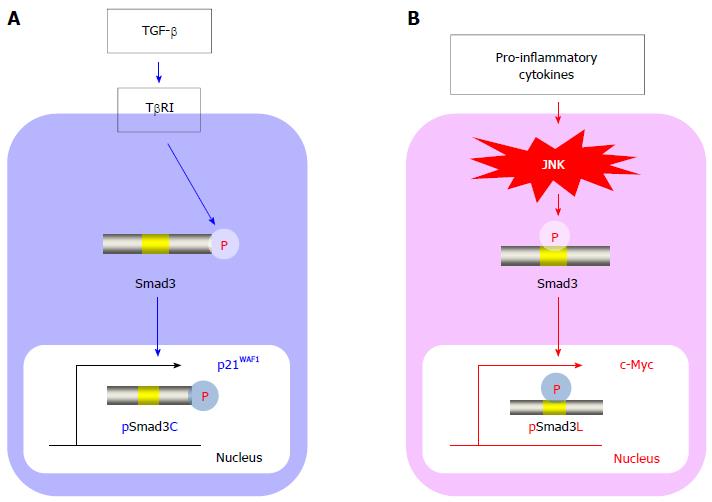Copyright
©2014 Baishideng Publishing Group Inc.
World J Gastroenterol. Sep 21, 2014; 20(35): 12381-12390
Published online Sep 21, 2014. doi: 10.3748/wjg.v20.i35.12381
Published online Sep 21, 2014. doi: 10.3748/wjg.v20.i35.12381
Figure 2 Smad3 phospho-isoform signaling: Tumor suppressive TβRI/pSmad3C pathway vs carcinogenic JNK/pSmad3L pathway.
A: In normal hepatocytes, transforming growth factor (TGF)-β activates the TGF-β type I receptor (TβRI), leading to the direct phosphorylation of the C-terminal region of Smad3. The C-terminal phosphorylated Smad3 (pSmad3C) moves to the nucleus and transmits cytostatic signals by up-regulating p21WAF1. The TβRI/pSmad3C pathway is crucial for homeostasis and is a tumor suppressor; B: In hepatocytes affected by mitogenic stimuli, pro-inflammatory cytokines activate c-Jun N-terminal kinase (JNK), drastically altering the Smad3 signaling to induce the phosphorylation of Smad3 at its linker region. The linker-phosphorylated Smad3 (pSmad3L) undergoes translocation to the nucleus to stimulate c-Myc transcription, resulting in a proliferative state. During hepatitis C virus-related chronic liver disease progression, the JNK/pSmad3L pathway is constitutively activated and promotes carcinogenesis.
- Citation: Yamaguchi T, Yoshida K, Murata M, Matsuzaki K. Smad3 phospho-isoform signaling in hepatitis C virus-related chronic liver diseases. World J Gastroenterol 2014; 20(35): 12381-12390
- URL: https://www.wjgnet.com/1007-9327/full/v20/i35/12381.htm
- DOI: https://dx.doi.org/10.3748/wjg.v20.i35.12381









